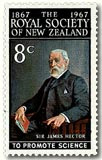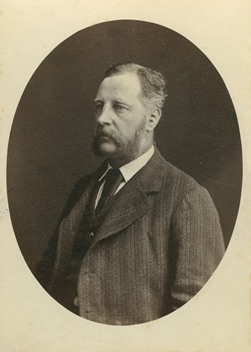Geologist and Science writer Nina Morgan describes the revival of a forgotten geological hero
 One of the most high profile honours a scientist can receive must surely be to appear on a postage stamp. And one of the least-known geologists to achieve this public recognition must be James Hector [1834 – 1907]. Born in Edinburgh, Hector received a medical degree from Edinburgh University in 1856, and thanks to a recommendation from Roderick Murchison [1792—1871], then Director of the Geological Survey of Great Britain, was appointed as surgeon and geologist on the Palliser Expedition [1857 – 60], which was searching for new routes in western Canada for the Canadian Pacific Railway. During the course of the expedition among other things, he measured the first stratigraphic section in the region; produced a geological map; found evidence of extensive former glaciation; and sketched out the structure of the Rocky Mountains.
One of the most high profile honours a scientist can receive must surely be to appear on a postage stamp. And one of the least-known geologists to achieve this public recognition must be James Hector [1834 – 1907]. Born in Edinburgh, Hector received a medical degree from Edinburgh University in 1856, and thanks to a recommendation from Roderick Murchison [1792—1871], then Director of the Geological Survey of Great Britain, was appointed as surgeon and geologist on the Palliser Expedition [1857 – 60], which was searching for new routes in western Canada for the Canadian Pacific Railway. During the course of the expedition among other things, he measured the first stratigraphic section in the region; produced a geological map; found evidence of extensive former glaciation; and sketched out the structure of the Rocky Mountains.
But in the Canadian popular imagination, Hector is best known not for his geological prowess, but for his involvement with the naming of Kicking Horse Pass – which straddles the Continental Divide on the border between British Columbia and Alberta. The name recalls an accident that nearly killed him.
Kick
While the Palliser expedition was exploring there in 1858, Hector was kicked in the chest by a horse. The result, recalled Metis Peter Erasmus, another member of the expedition, was that: "The doctor [Hector] was knocked unconscious. We all leapt from our horses and rushed up to him but all our attempts to help him recover his senses were of no avail... Dr Hector must have been unconscious for at least two hours." In Hector's own version of the story, his "grave was dug, and they were preparing to put me in it" when he regained consciousness and winked at them.
The Palliser expedition proved a great success and in 1860 Hector returned triumphant to London to write up the final report. But he wasn't there for long. In 1861, Murchison again recommended Hector for a job – this time for the Provincial Council of Otago, New Zealand.
Rise & fall
 Hector arrived in New Zealand in 1882, during the height of the Otago gold rush and set to work. After mapping huge areas in Otago Province, he produced the first geological map of the region in 1864. He went on to set up the New Zealand Geological Survey and Colonial Museum in 1865. Then, as the only scientist working for the New Zealand Government, he became the official adviser on all things scientific. At various times he found himself running many of New Zealand's scientific institutions. He was also instrumental in the development of what is now the Royal Society of New Zealand. In addition he published numerous scientific papers on topics ranging from geology to botany and zoology. He wrote two books: Handbook of New Zealand, first published in 1879, and Outline of New Zealand Geology, a summary of the first 20 years of the New Zealand Geological Survey.
Hector arrived in New Zealand in 1882, during the height of the Otago gold rush and set to work. After mapping huge areas in Otago Province, he produced the first geological map of the region in 1864. He went on to set up the New Zealand Geological Survey and Colonial Museum in 1865. Then, as the only scientist working for the New Zealand Government, he became the official adviser on all things scientific. At various times he found himself running many of New Zealand's scientific institutions. He was also instrumental in the development of what is now the Royal Society of New Zealand. In addition he published numerous scientific papers on topics ranging from geology to botany and zoology. He wrote two books: Handbook of New Zealand, first published in 1879, and Outline of New Zealand Geology, a summary of the first 20 years of the New Zealand Geological Survey.
But in the late 1880s, following a series of disagreements with members of the New Zealand scientific establishment, Hector fell from grace. Although he was knighted in 1887 and received numerous honours, he was relieved of responsibility for many of the organisations he ran. He retired from Government service in poor health in 1903, and died in 1907. His death was marked by obituaries in many scientific publications abroad, but he received little recognition in New Zealand at the time.
Resurrection
Sixty years after his death the tide turned, and Hector's reputation underwent a revival. In 1967 the New Zealand Post Office put the seal on Hector's return to grace by using his portrait on a stamp issued to commemorate the centenary of the founding of the Royal Society of New Zealand. And to top it off, the Geoscience Society of New Zealand has now established an annual Hector Day on 16 March, Hector's birthday. Celebrations range from picnics to cricket matches and geological field trips. All, it seems, has been forgiven.
Acknowledgements
The inspiration for this vignette came from the article Promoting geological heritage through postage stamps by Jane Dove, Geology Today, vol. 32, March – April 2016, pp 70 – 74. Additional information was gathered from the Wikipedia entry for James Hector; entries for Sir James Hector, Kicking Horse Pass and the Palliser Expedition on W: www.thecanadianencyclopedia.ca; entries about Hector on W: www.gsnz.org.nz/intormation/hector-day-i-9.html; and about his map on: W: www.otago.ac.nz/library/treasures/hector.
* Nina Morgan is a geologist and science writer based near Oxford. Her latest book, The Geology of Oxford Gravestones, is available via www.gravestonegeology.uk